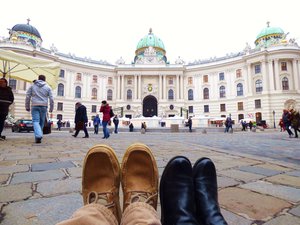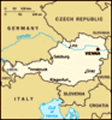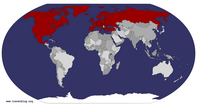Advertisement
Published: January 19th 2015

 Hofburg Palace
Hofburg Palace
Summer residence of the ruling Habsburgs and current home of the Austrian President.Music may be Vienna's finest export, but no less important are its political sway as a United Nations headquarter, historical significance as a UNESCO World Heritage Site, and social prowess as the world's most livable city with the highest quality of life according to numerous publications. Its role as the Austro-Hungarian Empire's capital before WWI made Vienna the foremost city in the German-speaking world, while its occupation by the four powers post-WWII imparted American, English, Russian, and French influences. Furthermore, close proximity to the Czech Republic, Hungary, and Slovakia helped turn Vienna-Prague-Budapest-Bratislava into the most popular itinerary for travelers in Eastern Europe today. In short, Vienna is a melting pot of cultures, although you wouldn't know walking down its streets.
As you venture around the city, you'll also encounter erected monuments and humble abodes of prominent figures. This is where Sigmund Freud gave birth to psychoanalysis, Gustav Klimt painted one of the most famous works ever created, and Wolfgang Mozart cemented his reputation as a composer. How Paris is perceived today as the cultural center and New York as the economic powerhouse of the world, Vienna was that centuries ago. But historic achievements of bygone eras are still present here,

 Graben
Graben
Vienna's premier shopping street. as evidenced by its architecture, cuisine, and customs.
To begin exploring, purchase a 24-hour public transit pass (24-Stunden Wien) for 7.60 Euros (9.26 USD) from machines at any metro station; Kristina and I opted for the 48-hour pass to suit our needs. This grants you unlimited access to all trams, buses, trains, and metro (U-bahn). If you wish to arrive at the city center coming from the Wien Erdberg bus stop like we did, hop on the U3 Orange line to the sixth stop, Stephansplatz. But first, we checked into our hotel, the Tourotel Mariahilf (Mariahilferstrasse 156), a charming, older establishment with large and clean rooms situated in the Mariahilf shopping district west of downtown. Next door to the hotel is a small grocery store where we bought some Almdudler, a grape and apple soda resembling ginger ale that is considered the national drink. We then returned to visit St.Stephans Cathedral, the tallest of its kind in Austria since no building during the empire was permitted to be taller than this landmark. The plaza surrounding Stephansdom is known as Stephansplatz, which many refer to as the heart of the city.
A couple blocks northwest of Stephansplatz is St.Peter's

 Schonbrunn Palace
Schonbrunn Palace
The imperial summer residence with Europe's top zoo and one of the world's best royal gardens.Church and nearby along the famous street, Kohlmarkt, is one of the top 25 bakeries in the world, Demel (Kohlmarkt 14). This was a favorite of the Habsburgs who ruled just steps away at the blue-domed Hofburg Palace, the imperial winter residence that today is home to the Austrian President. Demel's cakes were Empress Sisi' guilty pleasures before she was assassinated in Geneva in 1898, so we had to try one and ordered the popular milchrahmstrudel (milk cream strudel with vanilla), then went to the back to see the pastry chefs at work. Afterwards, we headed pass the horse carriages perpetually parked outside the Hofburg to arrive at the Burgtheater, the most important German-speaking theater in the world and in 1786, the site of
Le Nozze di Figaro's premier, Mozart's most famous opera.
Directly across the Burgtheater on the Ringstrasse--the main avenue encircling the Inner Stadt (inner district) and historic center-- is Rathaus. The word means "town hall," as it is the seat for the Mayor and city council. In addition to political functions, Rathaus serves as the site of Europe's premier Christmas market. We decided to roam the shops briefly knowing we would return at night when these

 Cafe Sacher
Cafe Sacher
Home of the original Sachertorte, a chocolate cake with a layer of apricot jam. markets come alive with lights and hot beverages to warm the frigid air. Thus, we proceeded south along the Ringstrasse passing the Parliament Building, a Greek-style home for the two houses of the Austrian legislature. Across from this is Volksgarten, a normally vibrant garden during the summer months that sadly during our visit, was quite dead. At the southern end is Heldenplatz, the plaza that comprises of the Austrian National Library (NeueBurg)--the largest library in the country and costs 7 Euros (10 USD) to enter--and the Hofburg Palace around the corner. On the other side of the street is Maria-Theresien Platz, part of the Museum Quarter. On either end of this square named after the only female ruler of the powerful Habsburgs and the mother of Marie Antoinette, are the Natural History Museum and the Art History Museum, both of which are identical buildings only distinguished by the statues on their facade. Kristina and I would return later for the Christmas market here to purchase our annual tree ornament.
We continued south to the Burggarten to pay homage to the Mozart Statue before making our way to the popular Bitzinger Wurstelstand (sausage stand) outside the Albertina art museum. This

 Demel Bakery
Demel Bakery
Top 25 bakery in the world offering world famous cakes like Sachertorte and strudelsfood cart on the corner of Augustinerstrasse and Hanuschgasse offers an assortment of delicious sausages quickly, conveniently, and affordably at only 3 Euros (4 USD) a dog. Choose from the traditional Bratswurst, the spicy Debreziner, or the cheesy Kasekrainer, all served in a bun and topped with mustard. This is a must-visit in a town that is the namesake for the Wiener.
After a savory dinner outdoors, we moved inside to enjoy some dessert at the world-renown Cafe Sacher (Philharmonikerstrasse 4). This is the home of the most famous cake in Vienna, the sachertorte, a thick chocolate cake split by a layer of apricot jam. This dessert was invented by Franz Sacher at Hotel Sacher in 1832 and the recipe was preserved by his son, who later worked for Demel bakery after the hotel shut down; new owners brought the hotel back years later, as well as the cake, which sparked debate over who deserved the title of its invention. After a nine-year legal dispute concluding in 1963, Cafe Sacher was allowed to advertise itself as "The Original Sachertorte," which became so popular in Austria that December 5 is hailed as National Sachertorte Day.
Since coffee breaks are

 Vienna State Opera
Vienna State Opera
Ornate interior of the Staatsoper, perenially rated as a top 10 concert hall in the world. an institution in this country, Kristina and I decided to enjoy a latte with the cake before heading out to experience another Viennese staple, the opera. The likes of Beethoven, Strauss, and Mozart have fortified this town's reputation as "The City of Music," and conveniently located next door to Cafe Sacher is the Vienna State Opera (Opernring 2), perennially rated as one of the top 10 opera houses in the world. There are plenty of world-class concert halls on the Ringstrasse, which many proclaim as the most famous street in the music world; with the Musikverein (home of the Vienna Philharmonic, whose season tickets are considered the hardest to obtain in Europe with a waiting list of 7 years) and the Wiener Konzerthaus both having addresses on this road, it has truly earned that title.
While purchasing a full-priced ticket at the Staatsoper may be expensive, standing tickets only cost 3 Euros for Galerie (3rd floor) and Balkon (2nd floor), and 4 Euros for Parterre (1st floor). Just remember to mark your spot with a scarf and queue for tickets starting 80 minutes before a performance on the side door under the arcade off of Operngasse. The opera on

 Rathaus Christmas Market
Rathaus Christmas Market
Markets full of punsch, langos, roasted chestnuts, and ornaments.slate for the night we arrived was
The Marriage of Figaro by Mozart, which was fortunate for us since only two performances of this were scheduled the entire month. This piece was originally scripted in German, but due to popular disapproval for German operas at the time, Mozart agreed to compose it in Italian at the behest of Emperor Joseph II, who also feared the opera's revolutionary message would cause political unrest and heighten public distaste for aristocrats. If you don't speak Italian, use the monitors on the back of seats for translations and make certain to research the plot prior, something Kristina and I didn't realize would be helpful until afterwards. Unable to comprehend any part of the opera, we left after an hour to marvel instead at the ornate interior of the concert hall before heading back to the Christmas markets at the Museum Quarter, Rathaus, and Stephansplatz.
By far the best experience at these markets is the food. The most popular appears to be langos, a Hungarian delicacy made of deep-fried flatbread. We tried both a naked langos and one stuffed with cheesy ham called langos kasekrainer, which we feel was the best meal we've had

 Schnitzel at Figlmueller
Schnitzel at Figlmueller
A filling lunch of soup and schnitzel at the famous Figlmueller.in Vienna. We then washed it down with some hot punsch, an alcoholic fruit beverage that we requested be virgin, in which case is called alkoholfreier jugendpunsch, German for "alcohol-free kids' punch". These drinks were undoubtedly the holiday favorite and cost only 2.50 Euros plus a 3 Euro deposit that you redeem once the mug is returned. Crowds of cold customers gathered around these punsch vendors, much more so than those offering roasted chestnuts or ornaments, both of which we purchased from during our stroll around the various markets. After a night full of fried treats and hot drinks, we retreated to the hotel to get some rest.
We started our second day in Vienna with a light breakfast of croissants and pizza pastries from Backerei-Konditorei Josef Schrott bakery (Mariahilferstrasse 159) in front of our hotel. We then hopped on Tram 58 going west to Schloss Schonbrunn, the imperial summer residence. Its public royal garden is rated as the best in the world and its zoo is ranked best and oldest in Europe, but the grounds are quite gloomy during the winter months so instead, hike up to the Gloriette viewing terrace atop the hill for a panoramic of

 Belvedere
Belvedere
A royal summer palace housing The Kiss by Klimpt.the entire city. Afterwards, meander through the Christmas market, which we were quite jaded to by this point, but not before trying a tasty croissant hotdog. We then took the U4 Green line to Stadtpark to visit the Strauss monument before continuing southwest to Belvedere, another summer palace featuring lush gardens and is home to
The Kiss by Klimpt, one of the most famous paintings in history. The original Lower and subsequent Upper Belvedere are Baroque structures built in the 1700s to house the ruling Habsburgs, now converted into a museum.
Next, head northwest towards Karlskirch (St.Charles Church), the site of yet another Christmas market. Then proceed on Treitisstrasse to the biggest outdoor market in Vienna, Nashmarkt. This is a cute covered venue for local vendors selling produce and novelties, from which we purchased a pizza-like flatbread with tomato and cheese called backer spitz, along with savory gruyere cheese and a salzstangeri baguette to enjoy on our walk pass the Musikverein to Figlmueller (Backerstrasse 6). This quaint little restaurant barely seats a few dozen people, forcing us to join a party of three Italians on vacation. The language barrier didn't stop us from conversing about the beauty of Italy

 Nashmarkt
Nashmarkt
Vienna's largest outdoor market housing vendors of all sorts. and the eyesore that is America while we tried the somewhat dry but still delicious flattened pork called schnitzel. After a filling lunch of soup and the schnitzel that made Figlmueller a culinary hotspot, Kristina and I walked around the city center and accidentally stumbled upon Mozart's apartment on Domgasse just east of Stephansplatz. This museum is worth a visit to say you've stood beneath Mozart's floorboards, but don't pay for admission into his now-renovated apartment where almost nothing is original. After a quick stint at Mozarthaus, we headed back to pack our bags and return to the bus station to make our voyage back to Prague.
Our mere 24 hours in Vienna whisked us back in time to a place of high society with rich desserts and elegant architecture. We have yet to visit France, but this is what we imagine as the Paris of Eastern Europe, fully equipped with their version of artisan cheese and fine wine. If you came here hungry and deaf, Vienna's food and music will reinvigorate your stomach and soul, so drop by the City of Music on your next trip to experience a different side of Europe.
Advertisement
Tot: 0.361s; Tpl: 0.014s; cc: 14; qc: 64; dbt: 0.0763s; 1; m:domysql w:travelblog (10.17.0.13); sld: 1;
; mem: 1.2mb























